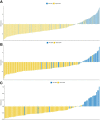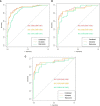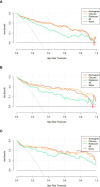Development and validation of A CT-based radiomics nomogram for prediction of synchronous distant metastasis in clear cell renal cell carcinoma
- PMID: 36686790
- PMCID: PMC9846314
- DOI: 10.3389/fonc.2022.1016583
Development and validation of A CT-based radiomics nomogram for prediction of synchronous distant metastasis in clear cell renal cell carcinoma
Erratum in
-
Corrigendum: Development and validation of A CT-based radiomics nomogram for prediction of synchronous distant metastasis in clear cell renal cell carcinoma.Front Oncol. 2023 Apr 12;13:1193426. doi: 10.3389/fonc.2023.1193426. eCollection 2023. Front Oncol. 2023. PMID: 37124532 Free PMC article.
Abstract
Background: Early identification of synchronous distant metastasis (SDM) in patients with clear cell Renal cell carcinoma (ccRCC) can certify the reasonable diagnostic examinations.
Methods: This retrospective study recruited 463 ccRCC patients who were divided into two cohorts (training and internal validation) at a 7:3 ratio. Besides, 115 patients from other hospital were assigned external validation cohort. A radiomics signature was developed based on features by means of the least absolute shrinkage and selection operator method. Demographics, laboratory variables and CT findings were combined to develop clinical factors model. Integrating radiomics signature and clinical factors model, a radiomics nomogram was developed.
Results: Ten features were used to build radiomics signature, which yielded an area under the curve (AUC) 0.882 in the external validation cohort. By incorporating the clinical independent predictors, the clinical model was developed with AUC of 0.920 in the external validation cohort. Radiomics nomogram (external validation, 0.925) had better performance than clinical factors model or radiomics signature. Decision curve analysis demonstrated the superiority of the radiomics nomogram in terms of clinical usefulness.
Conclusions: The CT-based nomogram could help in predicting SDM status in patients with ccRCC, which might provide assistance for clinicians in making diagnostic examinations.
Keywords: clear cell renal cell carcinoma; computed tomography; metastasis; nomogram; radiomics.
Copyright © 2023 Yu, Gao, Zhang, Sun, Zhang, Kang and Wang.
Conflict of interest statement
Author JZ was employed by GE Healthcare. The remaining authors declare that the research was conducted in the absence of any commercial or financial relationships that could be construed as a potential conflict of interest.
Figures






Similar articles
-
T1 Stage Clear Cell Renal Cell Carcinoma: A CT-Based Radiomics Nomogram to Estimate the Risk of Recurrence and Metastasis.Front Oncol. 2020 Nov 4;10:579619. doi: 10.3389/fonc.2020.579619. eCollection 2020. Front Oncol. 2020. PMID: 33251142 Free PMC article.
-
MRI radiomics-based nomogram for individualised prediction of synchronous distant metastasis in patients with clear cell renal cell carcinoma.Eur Radiol. 2021 Feb;31(2):1029-1042. doi: 10.1007/s00330-020-07184-y. Epub 2020 Aug 27. Eur Radiol. 2021. PMID: 32856163
-
Development and validation of a CT-based nomogram for preoperative prediction of clear cell renal cell carcinoma grades.Eur Radiol. 2021 Aug;31(8):6078-6086. doi: 10.1007/s00330-020-07667-y. Epub 2021 Jan 29. Eur Radiol. 2021. PMID: 33515086
-
A CT-based radiomics nomogram for differentiation of renal angiomyolipoma without visible fat from homogeneous clear cell renal cell carcinoma.Eur Radiol. 2020 Feb;30(2):1274-1284. doi: 10.1007/s00330-019-06427-x. Epub 2019 Sep 10. Eur Radiol. 2020. PMID: 31506816
-
A Computed Tomography-Based Radiomics Nomogram to Preoperatively Predict Tumor Necrosis in Patients With Clear Cell Renal Cell Carcinoma.Front Oncol. 2020 May 29;10:592. doi: 10.3389/fonc.2020.00592. eCollection 2020. Front Oncol. 2020. PMID: 32547934 Free PMC article.
Cited by
-
AI-powered radiomics: revolutionizing detection of urologic malignancies.Curr Opin Urol. 2024 Jan 1;34(1):1-7. doi: 10.1097/MOU.0000000000001144. Epub 2023 Nov 1. Curr Opin Urol. 2024. PMID: 37909882 Free PMC article. Review.
-
The predictive value of radiomics and deep learning for synchronous distant metastasis in clear cell renal cell carcinoma.Discov Oncol. 2025 Jan 25;16(1):86. doi: 10.1007/s12672-025-01806-x. Discov Oncol. 2025. PMID: 39862356 Free PMC article.
-
Navigating advanced renal cell carcinoma in the era of artificial intelligence.Cancer Imaging. 2025 Feb 18;25(1):16. doi: 10.1186/s40644-025-00835-7. Cancer Imaging. 2025. PMID: 39966980 Free PMC article. Review.
References
-
- Wei JH, Feng ZH, Cao Y, Zhao HW, Chen ZH, Liao B, et al. . Predictive value of single-nucleotide polymorphism signature for recurrence in localised renal cell carcinoma: A retrospective analysis and multicentre validation study. Lancet Oncol (2019) 20:591–600. doi: 10.1016/S1470-2045(18)30932-X - DOI - PubMed
LinkOut - more resources
Full Text Sources

